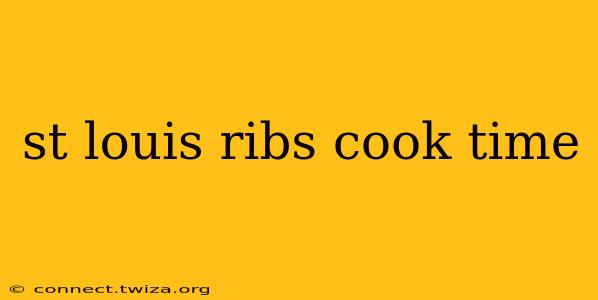St. Louis-style ribs are a culinary masterpiece, known for their meaty, flavorful goodness. But achieving that perfect balance of tender meat and a delicious bark requires understanding the nuances of cook time. This guide delves into the factors influencing cook time and provides a comprehensive approach to ensuring your St. Louis ribs are cooked to perfection every time.
What Factors Affect St. Louis Ribs Cook Time?
Several factors significantly impact the time it takes to cook St. Louis ribs. Understanding these will help you adjust your cooking strategy and avoid over or undercooking.
- Rib Rack Size and Thickness: Thicker racks of ribs will naturally require longer cooking times than thinner ones. Measure the thickness of your ribs before starting to get a better estimate.
- Cooking Method: Different cooking methods, such as smoking, grilling, baking, or using a combination, will affect cooking times considerably. Smoking, for instance, tends to take longer than grilling.
- Temperature: Lower cooking temperatures will generally produce more tender ribs but will require longer cooking times. Higher temperatures cook faster but risk drying out the meat.
- Desired Tenderness: Your personal preference for tenderness will also influence cook time. Some prefer fall-off-the-bone tenderness, while others prefer a bit more chew.
How Long Does it Take to Cook St. Louis Ribs?
There's no single answer to this question, but here’s a general guideline based on common cooking methods:
- Smoking: 4-6 hours at 225-250°F (107-121°C). This low and slow method yields incredibly tender, flavorful ribs.
- Grilling: 2-3 hours at medium-high heat (around 350-375°F or 177-191°C), often with a wrapping phase towards the end to ensure moisture.
- Baking: 2.5-3.5 hours at 300°F (149°C), typically wrapped in foil for part of the cooking process.
Important Note: These are estimates. Always use a meat thermometer to check for doneness. The ribs are done when the internal temperature reaches 190-205°F (88-96°C) and the meat is easily pulled away from the bone.
How Do I Know When My St. Louis Ribs Are Done?
The most reliable method is to use a meat thermometer. However, several other indicators suggest your ribs are cooked through:
- Internal Temperature: As mentioned above, an internal temperature of 190-205°F (88-96°C) indicates doneness.
- Bending Test: Gently lift a rib rack. If it bends easily without breaking, it's likely done.
- Visual Inspection: The meat should appear tender and slightly pull away from the bone. A beautiful, dark brown bark is another good sign.
What's the Best Temperature to Cook St. Louis Ribs?
The best temperature for cooking St. Louis ribs is generally considered to be in the lower temperature range (225-250°F or 107-121°C) for smoking, achieving maximum tenderness and flavor development. Higher temperatures will speed up the cooking process but may result in drier ribs.
Should I Wrap My St. Louis Ribs While Cooking?
Wrapping your ribs in foil or butcher paper during the cooking process is a common technique used to speed up cooking and enhance tenderness. The moisture trapped inside creates a steaming effect, making the ribs more tender. However, some pitmasters prefer to cook unwrapped to achieve a deeper smoke ring and a crispier bark. Experiment to see which method you prefer.
How Long to Cook St. Louis Ribs for Fall-Off-the-Bone Tenderness?
Achieving fall-off-the-bone tenderness usually requires longer cooking times, often extending beyond the general guidelines mentioned earlier. You might need to cook your ribs for an extra hour or more, depending on your cooking method and the thickness of the ribs. Monitor the internal temperature closely and use the bending test to assess doneness.
By understanding these factors and employing the techniques outlined above, you’ll be well-equipped to cook St. Louis ribs to perfection every single time, resulting in a truly memorable BBQ experience. Remember to always prioritize safety and use a reliable meat thermometer to ensure your ribs are cooked thoroughly.
